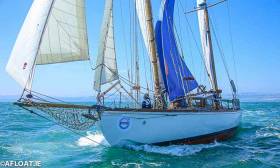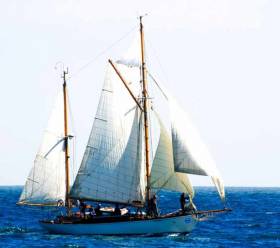Displaying items by tag: Maybird
Round Ireland Vintage Gaff Ketch Maybird Will Be Commemorated with New Trophy for June's Ocean Race
Darryl Hughes’ immaculately-restored 1937 43ft Tyrrell gaff ketch Maybird became both the oldest and the first gaff-rigged boat to complete the Round Ireland Race in 2018.
The historic yacht now moored in Cork Harbour on the Owenabue river is the centrepiece of a new trophy for June's 700-miler from Wicklow that is expected to draw a large entry when entries open on January 24th.
The Hughes’ 43ft ketch originally built by Tyrrell’s of Arklow in 1937 and restored with the owner as Project Manager in a superb two-year job concluded in 2011, got back to Wicklow in 2018 in a time of nine days and 22 hours.
In the workshop at his recently-acquired house in Crosshaven, Hughes crafted the Maybird Mast Trophy from timber salvaged from some of the ketch’s original spars.
As Afloat's WM Nixon previously noted, the resulting trophy will have added meaning in several ways, not least in that it will be a piece of high-quality woodwork which - in its original form - will have been handled by the great Jack Tyrrell himself, a world-renowned shipwright who gave real meaning to the term “hands-on management”.
New Date for Golden Oldie Round Ireland Show in Dublin
The unavoidably-postponed show in March by owner-skipper (and restorer) Darryl Hughes, of the classic 1937 43ft Tyrrell of Arklow ketch Maybird’s remarkable achievement in becoming (in 2018) the first gaff-rigged (and oldest) boat to complete the Round Ireland Race, has now been re-scheduled for Tuesday, April 9th.
The venue is once again the Poolbeg Yacht & Boat Club in Ringsend, Dublin, it is open to the public and under the auspices of the Dublin Bay Old Gaffers Association as their final show of the current winter season, with the admission of €5 going entirely to Irish Lifeboats.
See poster below.
Arklow-Built Classic is Honoured as Top Irish Gaff-Rigged Boat
Darryl Hughes’ renowned 43ft ketch Maybird, built by Tyrrell of Arklow in 1937 and superbly restored in substantial works project-managed by the owner himself in 2009-2011, has had – at 81 years old - probably her best year ever for awards in 2018 writes W M Nixon.
The highlight of her season was in July, when she became the first gaff-rigged boat to complete the 704-mile Volvo Round Ireland race from Wicklow. For this achievement, she received an immediate award from Wicklow SC and was immortalized in the gallery of ships’ portraits on the wall of Wicklow Pier itself, a special honour in a series created and lovingly maintained for many years by “Pat the Post”.
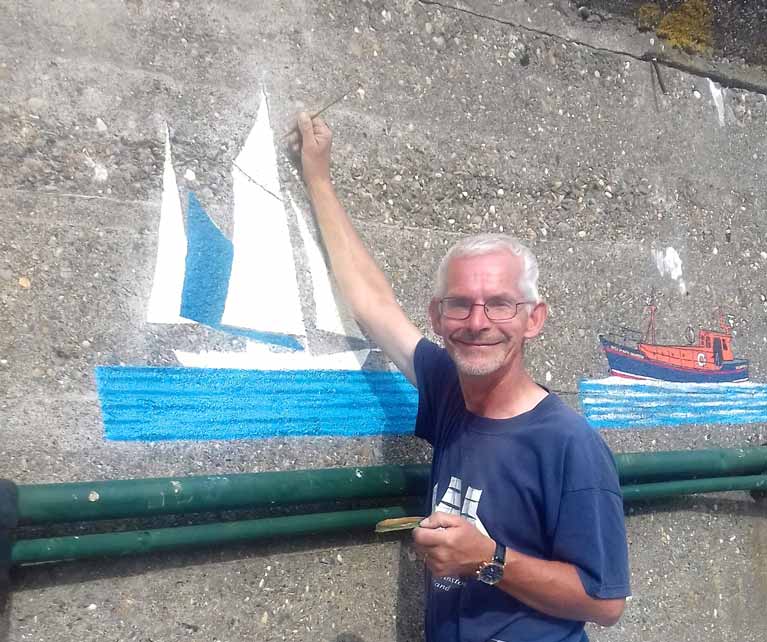 Wicklow’s “Pat the Post” creates one of his special portraits on Wicklow Pier in honour of Maybird.
Wicklow’s “Pat the Post” creates one of his special portraits on Wicklow Pier in honour of Maybird.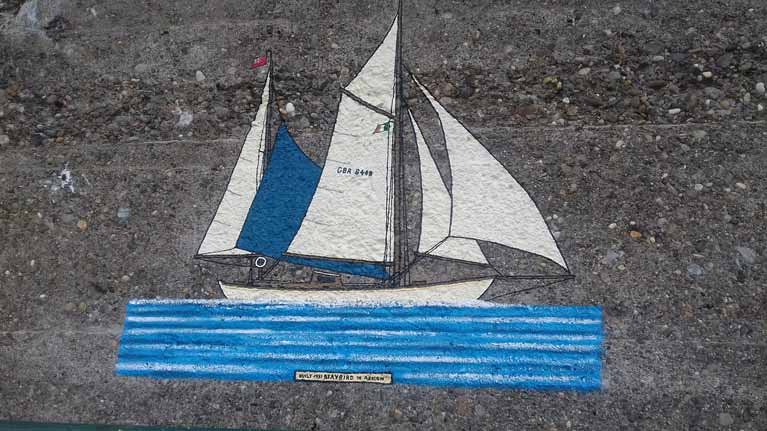 Maybird immortalized on Wicklow Pier
Maybird immortalized on Wicklow Pier
While this work was under way, Maybird meanwhile returned to her birthplace of Arklow for a week of celebration with Arklow Sailing Club and Arklow Sea Scouts, with sail-training sea-going groups availing of her presence for instructive gaff rig sessions, while the skipper and his round Ireland crew were honoured at the father-and-mother of all come-all-ye parties in ASC.
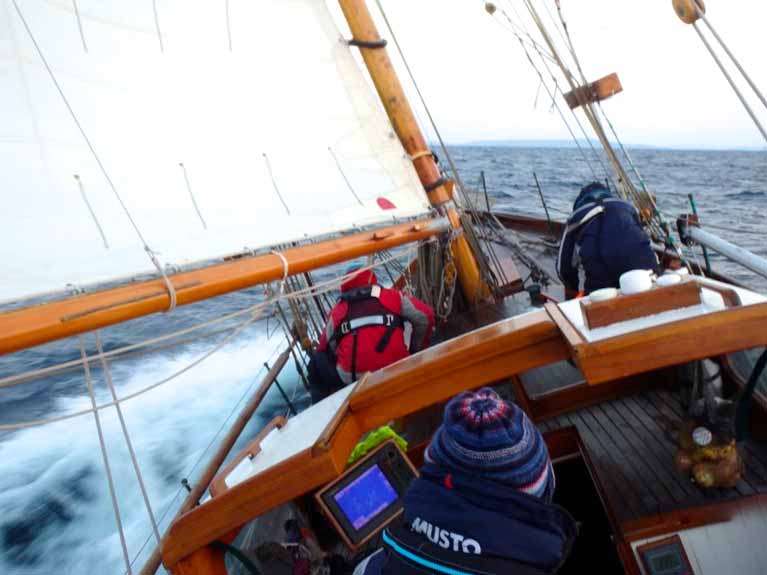 Aboard Maybird making knots during the Round Ireland race
Aboard Maybird making knots during the Round Ireland race
After this, the handsome ketch then sailed north, visiting several ports on a cruise which culminated in an Irish Cruising Club Rally at Rathlin Island on Ireland’s most northeasterly corner, and then in various ventures through the rest of the year she gradually got herself to Crosshaven where she has now been laid up for the winter, with her complex gear carefully stored.
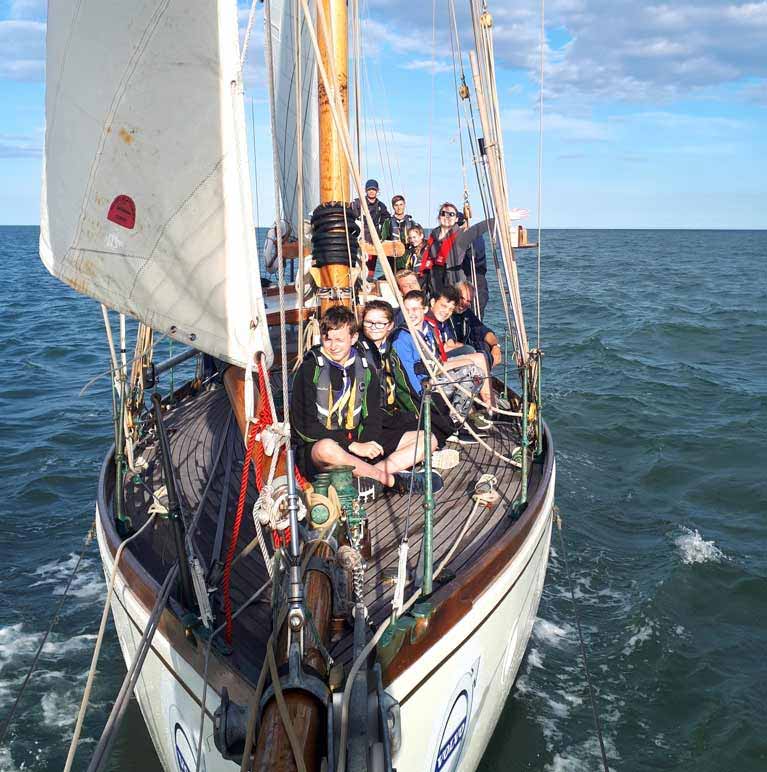 Arklow Sea Scouts out in strength on Maybird during the post-Round Ireland celebrations in her birthplace of Arklow
Arklow Sea Scouts out in strength on Maybird during the post-Round Ireland celebrations in her birthplace of Arklow
But with the end of the summer season, the flow of awards if anything increased. There was another trophy from Arklow Sailing Club at their annual awards ceremony. And then in November, Darryl Hughes found himself at the very convivial annual prize-giving of the Irish Sea Offshore Racing Association in the National Yacht Club in Dun Laoghaire, a black tie affair noted for its array of historical trophies.
Maybird had been obliged to do some ISORA Races in order to qualify for participation in the Round Ireland Race, and her crew enjoyed these events even though they hadn’t knowingly won anything in them. But in the NYC on that November Saturday night, it turned out they had – at the end of it all, Maybird’s name was called out as the winner of the Penmaen Plate.
The Penmaen Plate goes to the boat which best exemplifies “The Spirit of ISORA”. As Dun Laoghaire’s Peter Ryan, Chairman of ISORA, puts it: If you asked them to define the spirit of ISORA they’d be hard put to do so, but they know it when they see it, and in 2018 Maybird and her crew were the very embodiment of what they sought.
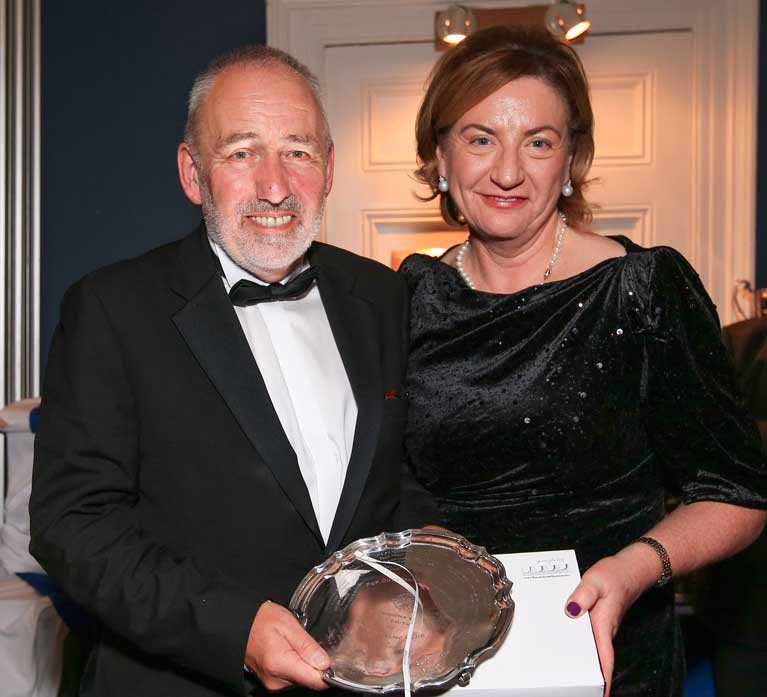 Darryl Hughes receives the Penmaen Plate from Anne-Marie Ryan, wife of ISORA Chairman Peter, at the ISORA Prize Giving Dinner in the National YC in Dun Laoghaire in November. Photo: gphoto
Darryl Hughes receives the Penmaen Plate from Anne-Marie Ryan, wife of ISORA Chairman Peter, at the ISORA Prize Giving Dinner in the National YC in Dun Laoghaire in November. Photo: gphoto
Darryl Hughes was busy in the late Autumn with voluntarily organizing the Irish Meteorology Society/Royal Institute for Navigation’s successful Weather & Sailing Conference in the Royal Irish YC on November 23rd. But after that he could relax back into normal life, and in late December he went along to the annual Christmas Party of the Dublin Bay Old Gaffers Association in Poolbeg Y&BC in the heart of Dublin, whose marina is Maybird’s home port when she’s on the East Coast.
And there, the season was finally fully rounded out when he found Maybird had become the 2018 winner of the Arthur Hughes Trophy, the top annual award of the DBOGA, named in honour of the memory of one of its key founders. So although Maybird already had been mightily honoured in Wicklow. Arklow and Dun Laoghaire, it was at Poolbeg in the final days of 2018 that she received the ultimate accolade as the top-achieving gaff rigged boat of the year
 It’s Christmas! Maybird is recognized as the top-achieving gaff rigged boat of 2018 at the Dublin Bay Old Gaffers Association Christmas Party in Poolbeg Y&BC, with the Arthur Hughes Trophy being presented to Darryl Hughes (right) by Negley Groom of DBOGA.
It’s Christmas! Maybird is recognized as the top-achieving gaff rigged boat of 2018 at the Dublin Bay Old Gaffers Association Christmas Party in Poolbeg Y&BC, with the Arthur Hughes Trophy being presented to Darryl Hughes (right) by Negley Groom of DBOGA.
Maybird Show In Arklow Will Be 80th Birthday With A Difference
The 43ft 1937 Tyrrell of Arklow-built gaff ketch Maybird has become a familiar sight in Irish waters in recent years writes W M Nixon. Bought in New Zealand in 2002 by Darryl Hughes (who hailed originally from Wales, but carved out a formidable international career in the security and electronics industry), she was shipped back to the UK with a full restoration eventually planned.
Everything pointed to getting it done in the Solent area, as that’s where you get the greatest concentration of highly-regarded specialists in the classic yacht industry in all its extraordinary variety and manifestations. But while the talents are undoubtedly there, if you channel them through one of the leading firms, the costs could be astronomical.
That said, when people in the know heard that Darryl had received a quote of around £500,000 from a highly reputable firm, there were those who reckoned it was a perfectly reasonable price. But Darryl knew he simply had to do it another way to bring it within his budget, which was more like £250,000.
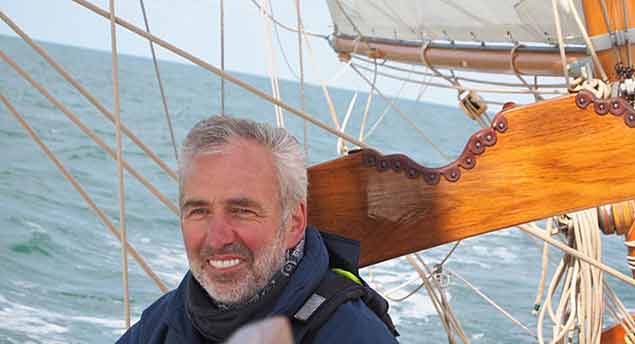 Darryl Hughes - happy aboard Maybird at sea. With his energy and enthusiasm, he was able to reduce the cost of restoring Maybird by 50% though being his own Project Manager
Darryl Hughes - happy aboard Maybird at sea. With his energy and enthusiasm, he was able to reduce the cost of restoring Maybird by 50% though being his own Project Manager
Successfully chopping 50% off a figure supplied by experts requires confidence, technical ability, unflagging energy, infectious enthusiasm, and the very coolest of judgement. Darryl Hughes has all these and more, and showed good sense from the start.
Typically, he called on the consulting services of classics naval architecture technologist and historian Theo Rye, in those days very much at the height of his powers as a globally-recognised expert on the highest quality yachts. As ever, Theo was generous with his help and advice, and that set the Hughes team on a course which resulted in a successful project which, in time, could well become a case study in what is now know as the gig economy.
Fond memories will be evoked for classic yacht enthusiasts everywhere by this brief video of the late Theo Rye with Maybird during the restoration project.
Darryl’s solution was to appoint himself Project Manager, get Maybird onto a low loader, and move her to a small vacant site he had identified on the quayside in the heart of the Southampton yacht industry. Once she’d been installed there as inconspicuously as possible, they immediately erected a “temporary” covering structure over her which, while weatherproof, still let the light through, and provided the essential minimum of space so that the boat could be enclosed in a convenient series of stagings, while leaving enough spare space for the temporary installation of workbenches and other wood machining paraphernalia.
 Wonderful what you can do with a “temporary structure”. The sacred place where Maybird was re-born in Southampton
Wonderful what you can do with a “temporary structure”. The sacred place where Maybird was re-born in Southampton
That said, the fact that some of the most sophisticated wood-working equipment in England was within a few yards on either side of them in vast sheds which were producing everything from pre-packs to finish the accommodation of the Oyster range up in Ipswich, to complete boats of the various marques most directly associated with Southampton, meant that it was essential that Darryl build up a network of mates to let him know when a specialist or two might be available for some specific task on Maybird during a slackening in some big production run.
Then too, Maybird was different from your usual run of classics. She wasn’t your usual elegantly long-ended creation of Fife or Herreshoff. On the contrary, she was an ocean-voyaging veteran, a rugged little yacht – or at least “little” by Southampton marine industry standards – and she came to be regarded as something of a mascot by the many exceptional talents who worked on her during a two year project, which was successfully completed in 2011.
Since then, she has completed the Fastnet Race, and covered many miles at sea, with an increasing number of them off the Irish coast. In fact, so much involved have Darryl and Maybird become with Irish sailing that this year he was elected a member of the Irish Cruising Club. It was particularly special that it should happen in 2017. In 1937, when she was new, her owner Colonel W E Hawkes – who lived in England but was originally of a Crosshaven sailing family – had been an ICC member since the early 1930s.
 ICC Rear Commodore Billy Mooney’s Aideen, built by Tyrrell’s in 1934, was the inspiration for Maybird
ICC Rear Commodore Billy Mooney’s Aideen, built by Tyrrell’s in 1934, was the inspiration for Maybird
He’d been inspired to built Maybird by the success of ICC Rear Commodore Billy Mooney’s Fred Shepherd-designed 42ft ketch Aideen, built by Jack Tyrrell in 1934. So when the team in Tyrell & Sons set out to build Maybird in the Autumn of 1936, the brief was “Aideen, only better”, and the result was a slightly longer and more stylish canoe stern which brought the new boat up to 43ft in overall hull length, while they also changed Billy Mooney’s mizzen gaff for a simpler Bermudan setup.
Maybird was a very welcome newcomer to the ICC’s fleet – a very small one in those days – and the fact that she was instantly part of it as soon as she was put afloat makes her re-joining of it exactly 80 year later all the more poignant.
For Colonel Hawkes was already an old man, and not in the best of health, when he had his dreamship built by Tyrrell’s. His years with Maybird were all too few. But Maybird’s life thereafter was interesting. For a few years, she even flew the British white ensign of an owner who was a member of the Royal Yacht Squadron, and by that time she sported a full Bermudan ketch rig.
 Maybird in her Royal Yacht Squadron years, rigged as a Bermudan ketch. With this rig, two emigrating families sailed her to New Zealand.
Maybird in her Royal Yacht Squadron years, rigged as a Bermudan ketch. With this rig, two emigrating families sailed her to New Zealand.
It was under this rig that she sailed to New Zealand, carrying two families who saw this as an affordable and interesting way to emigrate. One of the youngest on board was Dan Mill, and in an extraordinary twist of fate, he too has now ended up in Ireland, as he runs the busy boatyard in Galway Docks.
So Maybird’s links with many parts of Ireland are very special, but nowhere is more special to boat and owner than Arklow. The feeling is mutual, for few enough Arklow-built classic yachts make a point of visiting their birthplace whenever possible. This friendship – and Maybird’s 80th birthday – is being celebrated in Arklow Sailing Club on Friday 7th April 2017 at 8.00pm sharp for an illustrated talk by Darryl Hughes (and doubtless some others) on Maybird’s extraordinary history, her even more extraordinary restoration, and her remarkable involvement with so many aspects of Irish sailing life since it was completed.
All funds raised will be going to the RNLI, for one special episode in Maybird’s life back in Ireland came in May last year when - with a crew including Arklow RNLI people - she was entering the harbour to complete a passage from her winter berth in Crosshaven, and the engine cut out.
Everyone thought it was a stunt in that some RNLI personnel aboard Maybird were towed into port by their own lifeboat, for it happened to be the RNLI Fund-Raising Festival in Arklow. But it was for real, and caused much amusement. It will certainly add an extra edge to the fund-raising itself.
Yet who knows, but there might be another edge to it. For there will be people there whose fathers and forefathers worked on the building of Maybird in Tyrrell’s shed back in 1936-37. What would those craftsmen of yore have thought if a cheeky young Welshman had come along and set up a boat restoration project on the Arklow quayside right next door, and then chatted up their best shipwrights and other specialists to give of their time when there were lulls in the building of Maybird…..?
However, as the gathering of April 7th in Arklow Sailing Club will also be honouring the memory of Theo Rye, who was taken from us all too soon last November, we can be sure that goodwill and generosity prevail



























